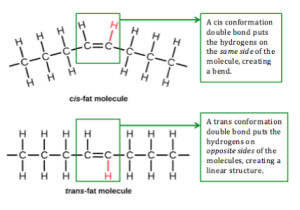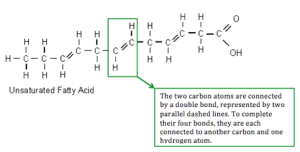
On June 16, 2015 the Food and Drug Administration (FDA) announced that partially hydrogenated oils (PHOs) or trans fats must be removed from all food products in the United States in three years. By removing trans fats, the FDA hopes to combat the occurrence of coronary heart disease and thereby prevent heart attacks for the American people. In an age where consumers are skeptical about what goes into their food and call for the removal of food ingredients left and right, it is important to understand why PHOs are being removed, and why other ingredients have not met the same fate.
Really, the story of trans fats begins with any type of fat and to understand what trans fats are, one must first understand fats in general. We’re trained to think that fat is bad and to avoid it, but fats or lipids are an important part of a healthy diet. Fats provide a source of energy that is more concentrated than carbohydrates, they are carriers for fat-soluble vitamins like A, D, E, and K, provide structure to cells, and are important for the development of the brain. Of course, there are some fats that are generally more beneficial than others. Saturated fats, like the fat that is typically found in animal sources, tend to be not as beneficial as fats from plant sources or unsaturated fats. It is recommended that adults consume about 1/3 of their daily calories from fat to keep their risk of developing cardiovascular or other diseases low.
So where do trans fats fit in all of this? In the food industry, trans fats occur when unsaturated vegetable oils are made more saturated by the process of hydrogenation, but only to a certain point, hence partially hydrogenated oils.
What does that mean?
A fat molecule is represented by the picture shown below. A fat molecule, or fatty acid is a long chain of carbon atoms, ending with a carboxyl group at the end. For this blog, the carbon chain is the most important. Carbon atoms can make four bonds. In this case, two to its neighboring carbons and two to hydrogen molecules. When a fat is saturated, this is the form that it takes.
However, when it is unsaturated, some carbons use two of their four bonds to bond twice with one of its neighboring carbons, creating a double bond. This means that carbon only has one bond to a hydrogen atom as seen below.
These double bonds are the first step in the creation of trans fats. In the food industry, it is sometimes favorable to add hydrogens to the unsaturated fats to make them more saturated or have less double bonds. This can lead to a better texture, more stability, and a longer shelf life. Fat molecules with many double bonds are especially susceptible to rancidity, which can cause a food to “go bad” so getting rid of some of those double bonds can allow the product to last longer. Additionally, for a product such as a butter spread, it is favorable to have a product that is solid, but spreadable at refrigeration temperatures, which is another benefit of hydrogenation. However, not all the double bonds can be saturated in this case, other wise the product would be too solid, so it is done only partially by the process of hydrogenation.
All right, so how are trans fats made?
During this process of hydrogenation, the fat molecules can take one of two forms: cis or trans. This is simply a difference in the orientation of the molecule. As seen below, trans fats tend to be more linear, which allows the molecules to pack closer together, keeping them from moving and making the fat more solid than liquid. The opposite is true for cis fats.

Although most molecules will take the cis conformation during hydrogenation, not all do, which leads to the creation of trans fats. Fat molecules in the cis conformation occur in nature and in plants. However, trans fat molecules do not, and are not processed in the body simply because the body doesn’t know how to process them. An accumulation or excessive intake of trans fats can cause a rise in low-density lipoprotein or LDL levels, which can cause the build up of plaque, which can harden arteries and cause heart disease, heart attacks, and stroke. Obviously, despite the benefits of trans fats in the functionality of products, the risks are not worth it.
Since a report published by the National Academy of Science’s Institute of Medicine in 2002, which linked the consumption of trans fats with heart disease, the FDA has required that the amount of trans fats be listed on nutrition labels since 2006, causing many food manufacturers to removed trans fats from their products all together. In 2013, after preliminary research, partially hydrogenated oils or trans fats were no longer considered “generally recognized as safe” or GRAS, which according to the FDA under the Food, Drug, and Cosmetic Act is determined to be:
“Any substance that is intentionally added to food is a food additive, that is subject to premarket review and approval by FDA, unless the substance is generally recognized, among qualified experts, as having been adequately shown to be safe under the conditions of its intended use, or unless the use of the substance is otherwise excluded from the definition of a food additive.”
After further research, the FDA decided to go along with their preliminary determination, and as of June 16, 2015 trans fats are no longer considered safe in any amount. However, food manufacturers have three years to comply with this ruling, which will allow them enough time to phase out partially hydrogenated oils or seek approval for any new additives.
What I think is the most important message to take away from this determination is that with probable cause and evidence, the FDA is more than capable of researching and removing a harmful substance from the food supply. I know that many may be frustrated that the same has not happened with other food ingredients that many consumers and bloggers have deemed to be unsafe such as synthetic colors or flavors, azodiacarconamide, or even genetically modified organisms. The fact is, all food ingredients are tested and determined to be safe before they are placed on the market. Sometimes, as with the case with trans fats, it is determined years later that they may be harmful after new research emerges. Until a probable cause is found, ingredients that are approved for consumption will still be available no matter what consumers have determined.
As for trans fats, until they have been officially and completely removed from all food products, consumers can avoid them by simply looking out for nutrition labels that contain trans fats or at ingredient labels for partially hydrogenated oils.
Sources
http://www.heart.org/HEARTORG/Conditions/Cholesterol/AboutCholesterol/Good-vs-Bad-Cholesterol_UCM_305561_Article.jsp
http://www.fda.gov/Food/IngredientsPackagingLabeling/GRAS/
http://www.fda.gov/ForConsumers/ConsumerUpdates/ucm372915.htm












